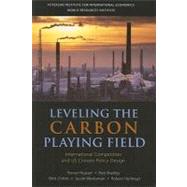
| Preface | p. ix |
| Executive Summary | p. xv |
| Acknowledgments | p. xxi |
| Introduction: How Climate and Competitiveness Fit Together | p. 1 |
| Background | p. 3 |
| Identifying Vulnerable Industries | p. 5 |
| A Broader View of Competitiveness? | p. 10 |
| Options for US Policy Design | p. 12 |
| Cost Containment Mechanisms | p. 15 |
| Price Caps | p. 16 |
| Borrowing and Banking Allowances | p. 18 |
| Free Allocation of Allowances | p. 20 |
| Tax Credits | p. 22 |
| Offsets | p. 23 |
| Exemptions | p. 24 |
| Containing Noncarbon Costs | p. 25 |
| Trade Measures | p. 29 |
| Designing a Trade Measure | p. 30 |
| Scenarios for Implementation | p. 38 |
| Effects on US Producers | p. 42 |
| Implications for International Engagement | p. 55 |
| Coordinated International Action | p. 59 |
| Prospects for International Engagement: The Case of China | p. 62 |
| Models for Cooperation on Industrial Emissions | p. 64 |
| Need for US Leadership | p. 71 |
| Scope for International Agreement | p. 71 |
| Conclusion | p. 73 |
| Cost Containment Mechanisms | p. 74 |
| Trade Measures | p. 75 |
| Coordinated International Action | p. 77 |
| Looking Forward | p. 78 |
| References | p. 79 |
| Glossary | p. 83 |
| About the Authors | p. 87 |
| Index | p. 89 |
| Tables | |
| Manufacturing-sector energy demand by industry, 2002 | p. 7 |
| US carbon-intensive industries and key products, 2005 | p. 11 |
| Cost containment mechanisms | p. 17 |
| Natural gas and electricity dependence in US industry (share of total energy demand), 2002 | p. 19 |
| US imports by origin, 2005 | p. 44 |
| US role in global production, trade, and carbon emissions, 2005 | p. 61 |
| Figures | |
| Manufacturing's declining role in the United States, 1948-2005 | p. 3 |
| US trade deficit and China's share, 1976-2006 | p. 4 |
| US industry exposure to climate costs based on energy intensity and imports as a share of consumption | p. 9 |
| Manufacturing share of total CO[subscript 2] emissions, 2005 | p. 25 |
| Net imports as share of US demand, 2005 | p. 43 |
| Share of US imports from Annex I countries, 2005 | p. 45 |
| Share of US imports from non-Annex I countries, 1986-2006 | p. 46 |
| Carbon intensity of steel, 2005 | p. 47 |
| Energy and carbon intensity index for chemicals, 2005 | p. 49 |
| Pulp used in paper production, 2005 | p. 50 |
| Cement kiln type and fuel source, 2005 | p. 51 |
| Demand growth by country grouping, 1991-2005 | p. 53 |
| Chinese production and exports as shares of global supply, 2005 | p. 54 |
| Chinese exports as share of domestic production, 2005 | p. 54 |
| Annual CO[subscript 2] emissions, historic and projected, 1974-2029 | p. 65 |
| Per capita CO[subscript 2] emissions, current and projected | p. 66 |
| Boxes | |
| Carbon tax versus cap and trade | p. 6 |
| Measuring carbon at the border | p. 33 |
| Defining "comparable" | p. 39 |
| US antidumping law: A questionable precedent | p. 41 |
| Porous borders | p. 56 |
| The sanctions track record | p. 57 |
| Lessons from WTO accession | p. 67 |
| Table of Contents provided by Ingram. All Rights Reserved. |
The New copy of this book will include any supplemental materials advertised. Please check the title of the book to determine if it should include any access cards, study guides, lab manuals, CDs, etc.
The Used, Rental and eBook copies of this book are not guaranteed to include any supplemental materials. Typically, only the book itself is included. This is true even if the title states it includes any access cards, study guides, lab manuals, CDs, etc.